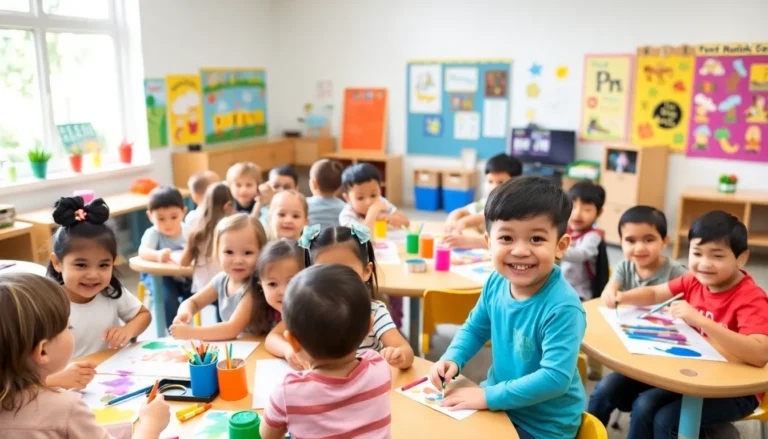Table of Contents
ToggleCollege classrooms are a unique blend of chaos and enlightenment, where the quest for knowledge meets the art of procrastination. Picture this: a room filled with eager minds, caffeine-fueled debates, and the occasional existential crisis over a group project. It’s a microcosm of life, where students learn not just from textbooks, but from each other—often while trying to stay awake during a 9 AM lecture.
These vibrant spaces are more than just four walls and desks; they’re the breeding grounds for innovation, collaboration, and yes, some of the best stories that’ll be told for years to come. As students navigate through lectures, discussions, and the occasional awkward silence, they’re not just preparing for exams—they’re gearing up for the unpredictable ride of adulthood. So, buckle up and get ready to explore the fascinating world of college classrooms, where every day is a new adventure in learning.
Overview of College Classrooms
College classrooms embody a unique blend of learning and interaction. Equipped with technology, these spaces support diverse teaching methods, from lectures to interactive group work. Desks and chairs often accommodate various arrangements to facilitate collaboration, enhancing student engagement during discussions.
Many classrooms utilize smartboards and projectors, fostering dynamic presentations that capture attention. Lecturers encourage participation, stimulating debates that help deepen understanding of complex subjects. Conversations between peers often extend beyond academic topics, creating friendships and networks essential for future careers.
The atmosphere varies throughout the day. Early morning classes may see tired students, while afternoon sessions often buzz with heightened energy. Some institutions prioritize flexible seating to promote comfort and creativity, catering to the diverse preferences of learners.
Classrooms also serve as centers for innovation. Group projects often challenge students to think critically and problem-solve as they work together. The diversity in student backgrounds enhances the learning experience, as individuals share unique perspectives and insights.
This combination of academic focus and social interaction prepares students for real-world challenges. As they navigate group dynamics and engage in collaborative projects, they develop essential skills such as teamwork, communication, and adaptability. Overall, college classrooms are not merely places for instruction; they represent vital spaces for personal and intellectual growth.
Types of College Classrooms

College classrooms come in various formats, each designed to optimize the learning experience. These environments cater to different teaching methods and learning styles, making education dynamic and engaging.
Lecture Halls
Lecture halls typically accommodate large groups of students. These spaces feature tiered seating to enhance visibility and acoustics, allowing professors to deliver content effectively. A focus on traditional lectures characterizes this setting, with instructors often using multimedia presentations to convey information. Students may find the atmosphere more formal, but lively discussions can emerge during question periods. Instructors leverage technology, utilizing microphones and projectors to facilitate effective communication.
Seminar Rooms
Seminar rooms provide a more intimate setting than lecture halls. These spaces often accommodate smaller groups, fostering engaging discussions and collaborative learning. Seating arrangements are usually flexible, promoting interaction among students and between students and instructors. A focus on student participation defines this environment, encouraging diverse viewpoints. Instructors guide discussions, prompting critical thinking and in-depth analysis of subjects. Students benefit from stronger connections and the opportunity to delve deeper into topic material.
Labs and Studios
Labs and studios serve specialized learning needs, emphasizing hands-on experience. Science labs allow students to conduct experiments, improving understanding through practical application of theory. Studio spaces cater to creative disciplines, providing resources for art, design, and performance-based subjects. Collaboration characterizes these environments, as students work together to solve problems and create projects. Instructors facilitate learning, providing support and guidance while students explore and innovate within their fields. Each lab and studio fosters essential skills, preparing students for future careers.
Classroom Technology
Classroom technology enhances the learning experience in college environments. Smartboards and projectors serve as essential tools for modern education.
Smartboards and Projectors
Smartboards facilitate interactive lessons that engage students in dynamic ways. These devices enable instructors to display multimedia presentations while allowing students to interact directly with content. Updates to lesson materials become straightforward, which fosters a seamless integration of new information into the curriculum. Projectors complement smartboards by providing clear visuals for larger audiences, ensuring everyone can see essential content. The combination creates a lively learning atmosphere, encouraging participation and collaboration during discussions.
Online Learning Platforms
Online learning platforms play a significant role in today’s college classrooms. These platforms offer resources such as lecture notes, video lectures, and forums for discussion. Flexibility in accessing materials promotes independent learning, catering to diverse student schedules. Interaction with peers occurs through discussion boards, where ideas and perspectives are exchanged. Analytics embedded in these platforms help educators track student progress and adjust teaching strategies. Engaging with these tools prepares students for real-world scenarios, fostering essential tech skills needed in the workforce.
Student Engagement in Classrooms
Student engagement in college classrooms plays a crucial role in enhancing the learning experience. Various factors influence this engagement, including classroom design, technology use, and teaching methods. Flexible seating arrangements captivate students, allowing them to collaborate easily and discuss ideas more freely.
Active learning strategies encourage participation, fostering lively discussions that enrich the educational atmosphere. For example, group projects compel students to think critically, while diverse backgrounds enhance conversations, offering unique perspectives on various topics.
Technology also significantly impacts student engagement. Interactive smartboards engage students by making lessons more dynamic and visually stimulating. Projectors play a complementary role, presenting clear visuals that accommodate larger groups, maintaining students’ attention during lectures.
Using online learning platforms adds another layer to engagement, providing accessible resources like video lectures and discussion forums. These platforms enable students to engage with material outside of class, promoting independent learning. Educators benefit from analytics provided by these platforms, helping them track student progress and tailor teaching strategies accordingly.
Overall, dynamic college classrooms not only focus on academic instruction but also create environments that foster collaboration and innovation. Each element contributes to preparing students for real-world challenges while enhancing their teamwork, communication, and adaptability skills.
College classrooms are much more than just spaces for lectures and exams. They serve as vibrant ecosystems where students engage with each other and their instructors in meaningful ways. The blend of technology and innovative teaching methods cultivates an environment ripe for collaboration and critical thinking.
As students navigate these dynamic settings they not only absorb academic knowledge but also develop vital skills that will serve them well in their future careers. The variety of classroom types ensures that every learning style is accommodated, fostering a sense of community and shared purpose among diverse groups.
Ultimately, college classrooms play a crucial role in shaping the next generation of thinkers and leaders. They prepare students to tackle real-world challenges with confidence and creativity, making them indispensable to the educational journey.







